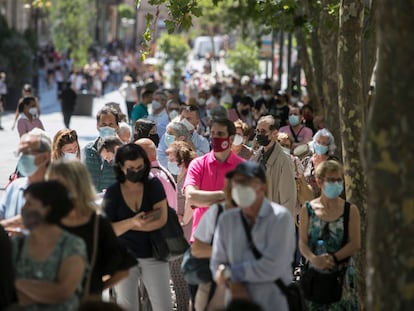Forgotten, lost or collected: Spaniards hang on to peseta coins and banknotes worth €1.6 billion
The deadline to exchange the former currency for euros has now passed, but unlike in countries such as France or Portugal, a surprisingly large amount has not been returned
It’s enough money to cover the cost of the planned expansion of Madrid’s Adolfo Suárez-Barajas airport, or to pay for the latest offer from Real Madrid soccer club for the PSG player Kylian Mbappé nine times over. But what just a few weeks ago was a fortune that was scattered across thousands of Spanish households is completely worthless today, apart from for collectors. A total of 262 billion pesetas – worth some €1.6 billion – have been kept by Spaniards, according to the final tally put together by the Bank of Spain. That’s €33 per resident of Spain, were it to be shared out among the 47 million people in the country.
Forgotten in drawers or chests, lost on the beach or in the countryside, or stashed away with nostalgic fervor, around €793 million in banknotes and €782 million in coins have gone without being exchanged for euros. It’s a hefty sum when compared to Portugal, which saw a total of €40 million remain in escudos. In France, citizens only kept back €526 million of francs, despite the country having a bigger economy than Spain’s and having left a shorter time frame for exchange – until February 2012.
One-peseta coins have often been used to make beer barrels, while those worth 10, 50 or 200 pesetas are often repurposed into refrigeration tubes
While the sums in Spain are dizzying, the majority of the pesetas still in circulation were returned a long time ago. The euro came into circulation on January 1, 2002, and in its first six months of life 94.5% of pesetas were exchanged. From that point onward, there has been a steady stream of deposits, bringing the total returned to 96.8% over the last 19 years.
That is to say that 3.2% will never reach the hands of the central banking authorities. But the state will not benefit from this now-worthless currency as if it were an injection of millions of euros. According to the Bank of Spain, after the introduction of the euro, forecasts were made as to the amount of pesetas that may never be exchanged, and provisions were made on the balance sheet of the central lender. As time has passed, estimates were updated according to the exchanges made. In 2020, there was a provision of just €14.73 million, and that has been sufficient for the last flurry of banknotes handed over. What’s left will return to the bank’s reserves. In the case of coins, which are the responsibility of the Treasury, what’s been exchanged has been directly discounted from its account at the Bank of Spain.
The process progressed without much attention until the deadline approached. Restrictions introduced due to the coronavirus pandemic saw the Bank of Spain extend the final date to return pesetas by six months from its initial date of December 31, 2020. But despite the extra time, after a nearly two-decade period when the currency could be exchanged for pesetas, there were long lines at the Bank of Spain on the very last day, as well as frustration among those who had arrived too late. There was even an improvised bartering market between those who were left out in the cold and those who were just about to get their turn with a teller at the central lender.
Boat propellers
The banknotes and coins for which Spaniards worked over the 133-year existence of the peseta will be handed over by the Bank of Spain to the Treasury. It will decide whether to use them for scrap, sell them or find another purpose for them. The one-peseta coins have often been used to make beer barrels, while those worth 10, 50 or 200 pesetas are often repurposed into refrigeration tubes. Boat propellers are the usual destination for coins worth 5, 25, 100 and 500 pesetas.
In the case of banknotes, the bank shreds them down into pieces measuring little more than a millimeter, before the material is compacted and mostly recycled. Once completely unrecognizable, and in a new form, the former currency has a chance of returning to the hands of its previous owners.
English version by Simon Hunter.
Tu suscripción se está usando en otro dispositivo
¿Quieres añadir otro usuario a tu suscripción?
Si continúas leyendo en este dispositivo, no se podrá leer en el otro.
FlechaTu suscripción se está usando en otro dispositivo y solo puedes acceder a EL PAÍS desde un dispositivo a la vez.
Si quieres compartir tu cuenta, cambia tu suscripción a la modalidad Premium, así podrás añadir otro usuario. Cada uno accederá con su propia cuenta de email, lo que os permitirá personalizar vuestra experiencia en EL PAÍS.
¿Tienes una suscripción de empresa? Accede aquí para contratar más cuentas.
En el caso de no saber quién está usando tu cuenta, te recomendamos cambiar tu contraseña aquí.
Si decides continuar compartiendo tu cuenta, este mensaje se mostrará en tu dispositivo y en el de la otra persona que está usando tu cuenta de forma indefinida, afectando a tu experiencia de lectura. Puedes consultar aquí los términos y condiciones de la suscripción digital.
More information
Últimas noticias
Most viewed
- Sinaloa Cartel war is taking its toll on Los Chapitos
- Oona Chaplin: ‘I told James Cameron that I was living in a treehouse and starting a permaculture project with a friend’
- Reinhard Genzel, Nobel laureate in physics: ‘One-minute videos will never give you the truth’
- Why the price of coffee has skyrocketed: from Brazilian plantations to specialty coffee houses
- Silver prices are going crazy: This is what’s fueling the rally










































